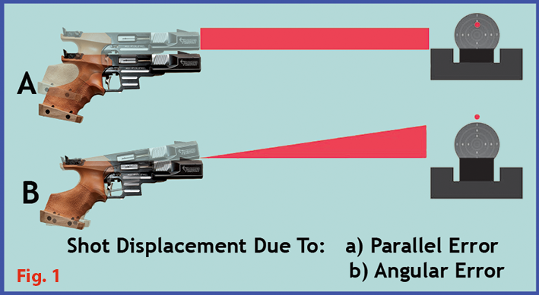
It is uncommon to purchase a pistol for a specific match and an individual athlete that does not require some modifications to suit. Modifications may include altering the grip, adding weights, changing sight sizes, or simply adjusting the position of items to fit the athlete. Some manufacturers may provide extra front sight elements or barrel weights, but the majority of accessories need to be purchased separately.
Each athlete will perceive how they see the size of sights and its relationship to the target differently, just the same as each athletes hand is a different size and shape. The same can be said of how the athlete feels the trigger position, weight, stages, let off, and stop. There are various elements of the pistol that can be adjusted or modified and the following are a few of them:
- Front sight – width, radius to rear sight
- Rear sight – shape, ‘U’ or square; depth; width of light spaces
- Barrel weights – pistol balance, muzzle movement
- Trigger – position; blade/shoe orientation; single stage, two stage, rolling type
- Grip – correct fitment, alignment
The coach can guide the athlete by providing advice on how changes to the pistol can impact what is going on, but only experimentation and how the athlete feels or perceives the advantage or disadvantage of the pistols set up will determine what is used. Changes should be made one at a time with notes taken over a period of time for testing the change, before making a decision to adopt the change or reject it (Potter, W.)
The front sight
Some front sights are only a single size and may need to be replaced, whilst others may have three faces of varying widths. Some may be able to be moved to change the sight radius; and occasionally the front sight may come in different heights to allow for greater sight alterations between aiming areas in 25m Sport or Centre-fire events.
Front sights are usually black, preferably a nice dull, matt black in colour, with the only exceptions being a few revolvers and semi-automatics that have coloured fibre-optics or similar inserts, which are of use in low light or personal defence type shooting. Coloured sights are not used in ISSF events as it has been conclusively found that the best colour for sights is dull, matt black (Antal, 1989. Yur’ Yev, 1973.)
Front sight width
For the precision targets 50m, 25m, 10m the general consensus is that the front sight should be for the individual athlete as wide as, or slightly less than the apparent width of the black, which is around 5mm or less (Antal & Skannaker, 1985. Standl, 1979. Reinkemeier et al, 2013. Yur’ Yev, 1973).
Radius between sights
The principle of having a long sight radius is that it is easier to detect misalignment of the front sight and reduces angular error (Fig. 1) giving better accuracy; however a long sight radius must be weighed against the athletes ability to be able to hold good sight alignment as the distance between the front sight and rear sight increases; and the front sight being further away from the pivot point of the wrist makes control of the movement of the front sight more difficult (Fig. 2). Certainly developing athletes will find it easier to control the movement of the front sight post within the rear sight gap when the sight radius is shorter.


Make a free website with Yola
